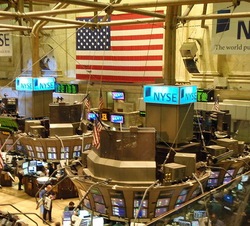 How Literature Informs and Influences Our Relationship to Food
How Literature Informs and Influences Our Relationship to Food
Faculty expert Allison Carruth is an assistant professor of English. She focuses her work on the confluence of food, literature and global power at a time when the Slow Food and environmental justice movements are focused on transforming agriculture. In her book manuscript, Global Appetites: Imagining the Power of Food, she examines how writers—along with artists, activists and political leaders—have portrayed the food system since World War I, a period when the United States achieved global power in part through industrialized agriculture. As food progressives seek a sustainable and socially just model for food production and consumption, Carruth says both the problems and the answers just might be found in the arts.
 Q: Why do you see a link between food production and storytelling?
Q: Why do you see a link between food production and storytelling?
A: The modern food system is not just a matter of economics, technology or science––the ways we cultivate and consume food are tied to the imagination. Whether making soup from potatoes or tortillas from maize, the process of turning raw ingredients into food is a cultural practice shaped by the narratives communities share about both agriculture and eating.
Literature, through devices like character development and metaphor, is well suited to examine the transformation of the food system over the last century. Writers weave large-scale questions about industrialization and global trade into interpersonal narratives about food. For instance, a writer can develop a drama revolving around characters who are hungry, as Samuel Beckett does in Waiting for Godot, and inflect that drama with the politics of food rationing during World War II.
Q: What can literature tell us about our relationship with food?
A: The literary arts play a vital role in how we understand historical transformations. In the contemporary period, there has been growing awareness about the implications of a global, industrialized food system. This awareness has been spurred, in no small measure, by writers and artists.
In fact, the literature of food has long been tied to how cultures define themselves and articulate complex ideas––about community, identity and the natural world. The ancient pastoral literary tradition, for example, depicts husbandry as a realm of work that mirrors natural cycles and counters the realities of war and politics. This tradition continues to permeate American culture, contributing to the belief that farming is sheltered from forces of modernization.
Stories of breaking bread or of shepherds tending their flocks are central to how we define the human experience. But these metaphors became less meaningful after World War I as agriculture became industrialized and as conflicts arose between the interests of global food trade and regional food traditions. From Willa Cather in the early twentieth century to Michael Pollan today, writers have traced these changes and have illuminated the political and ethical implications.
 Q: You write that World War I represented a significant milestone in depictions of food. How so?
Q: You write that World War I represented a significant milestone in depictions of food. How so?
A: The war represented a paradigm shift in both farming practices and in the story of food. In the U.S., industrial agriculture modernized through the use of synthetic fertilizers and through the adaptation of war technologies such as barbed wire, which was used in trench warfare and then revolutionized ranching.
These developments in turn influenced writers. Willa Cather, for instance, grew up in the Great Plains in the early 20th century and is best known for her representations of pioneers. But after World War I, a significant shift occurs in her writing as she turns her attention to this new relationship between war and agriculture. In her novel One of Ours, the protagonist suffers brutal injuries when a tractor scares his horse and sends him crashing into a barbed wire fence. This scene is one of many that explore the changing structure of American agriculture. Cather’s Nebraska farmers not only make use of new technologies like the tractor, they also follow the financial news to track global commodity prices. As she and other writers illuminate, American agriculture after the Great War relies on and helps to fuel the global economy.
Q: How did the depiction of food in literature evolve after World War I?
A: Between World War I and World War II, writers such as George Orwell and M.F.K. Fisher shifted attention from industrial agriculture to new food distribution patterns. At that time, food rationing was promoted as an act of patriotism, while a new global framework emerged for providing food aid. The writers I examine question why world famine persisted at a time when U.S. food production was more prodigious and efficient than ever before.
If we flash forward to the era between the 1970s and 1990s, we find writers grappling with the implications of free trade. Toni Morrison’s Tar Baby, for example, is set in a francophone Caribbean country and revolves around the global politics of chocolate. The novel explores how free trade––and the appetites of consumers around the world–– transforms the economy and ecosystem of local communities.
Q: Why has there been this uptick in food nonfiction recently?
A: Over the last decade, we’ve witnessed an explosion of nonfiction about the food systems—works such as the documentary Food Inc., Eric Schlosser’s book Fast Food Nation and Michael Pollan’s Omnivore’s Dilemma. These works connect the environmental movement with the food movement, for which Pollan serves as a lightning rod. These writers have raised awareness about the politics of food in the United States.
 However, there are important issues that these writers fail to address. Pollan, for instance, has focused on our overproduction of corn for animal feed and processed foods and that is an important story. But Pollan and others tend to shy away from the politics of farm labor as well as the interconnectedness of farming communities around the world. Yet these global questions are vitally important. In Mexico, for instance, farmers struggle to grow a diverse array of maize in part because genetically modified corn from the U.S. now dominates their agriculture.
However, there are important issues that these writers fail to address. Pollan, for instance, has focused on our overproduction of corn for animal feed and processed foods and that is an important story. But Pollan and others tend to shy away from the politics of farm labor as well as the interconnectedness of farming communities around the world. Yet these global questions are vitally important. In Mexico, for instance, farmers struggle to grow a diverse array of maize in part because genetically modified corn from the U.S. now dominates their agriculture.
Q: What can these burgeoning food movements learn from the history of food narratives?
A: We need a food system that is not only ecologically viable but also socially equitable, a system that treats food communities around the world with reciprocity and with regard for regional needs and traditions.
Even as we work to support small farms, change eating practices and reduce the carbon footprint of agriculture, we might also reflect on which modern developments might be of value. While some argue for a return to preindustrial farming, I have spoken with farmers and farm workers who remind us that their work can be backbreaking and certain technologies––from the tractor to the computer––can offset these challenges.
Narratives about the history of the food system are crucial to imagining how we will grow and eat food in the future. Those narratives are found not just in literature but also in everything from murals in urban community gardens to video games developed by the U.N. World Food Program. By studying the literary history of food, we also can find alternative stories to those of industrial agriculture and perhaps develop a blueprint for future food production that is more just and sustainable than the status quo.
Interview by Marc Dadigan




 Learn how experts across disciplines are together advancing green chemistry.
Learn how experts across disciplines are together advancing green chemistry.